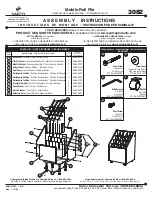
Section 4 • Repair Procedures
REV A
4 - 20
AL8000HT Light Tower
Part No. 116478
September 2008
7-2
Light Ballast
How to Check a
Ballast Capacitor
Electrocution hazard. Exposure to
high voltage electrical wires or
electrical current will result in death
or serious injury. Remove all rings,
watches and other jewelry. Use
extreme caution when working with
high voltage electrical
components.
Electrocution hazard. Attempting
to service the machine before the
capacitors are fully discharged
could result in death or serious
injury.
Note: Be sure the engine has been turned off for at
least 15 minutes before servicing the machine. Use
a voltmeter to confirm there is no residual voltage
in the capacitors.
Note: This procedure is only for the capacitors
which are attached to the lighting ballasts. To test a
generator capacitor, see 6-1,
How to Check a
Generator Capacitor.
1 Open both cabinet doors and locate the light
ballast boxes on each side of the machine.
2 Choose a ballast box. Tag and disconnect the
wire harness connector from the ballast box.
Note: If the ballast capacitor to be tested is located
under another ballast box, the top ballast box will
need to be removed first.
CHASSIS COMPONENTS
3 Remove the ballast box cover fasteners.
4 Using an insulated conductor or a screwdriver
with an insulated handle, discharge the
capacitor by shorting across the capacitor
terminals.
Electrocution hazard. Exposure to
high voltage electrical wires or
electrical current will result in death
or serious injury. Remove all rings,
watches and other jewelry. Use
extreme caution when working with
high voltage electrical
components.
5 With an ohmmeter set to its highest resistance
scale, connect the ohmmeter leads to the
capacitor terminals and observe the reading on
the meter. Then, reverse the connections and
observe the reading on the meter.
Result: The meter indicates a resistance which
then gradually decreases. The capacitor is
working.
Result: The meter indicates a very high
resistance which does not decrease. The
capacitor is faulty and should be replaced.
Result: The meter indicates a very low
resistance which does not increase. The
capacitor is faulty and should be replaced.
Probable causes of capacitor failure:
· Normal end-of-life failure.
· Overheated due to light fixture heat or high
ambient temperature.
· Incorrect capacitor voltage rating.
· Capacitor becomes loose in ballast box.
















































